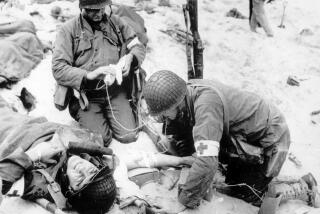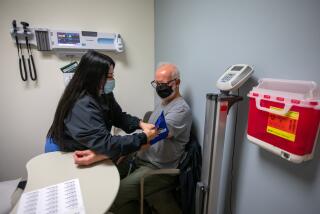AMA Leader Sees New Era in Medical Care
When Dr. Harrison L. Rogers Jr. finished his training in surgery and hung out his shingle in Atlanta in 1957, he had to go to a banker friend of his family and arrange for $1,000 monthly loans to make it through his first year in practice.
He was able to start paying back the cash advances within about 1 1/2 years and went on to establish himself as a general surgeon. From there, Rogers’ career advanced, taking him this year to the presidency of the American Medical Assn., in which he serves as the chief spokesman for the nation’s private practice physicians.
Like AMA presidents before him, Rogers came to realize before his election that the year he will spend as the top elected officer of the nation’s largest medical trade group will require massive amounts of travel--at least 250,000 miles--and will leave little time to practice medicine. So, also like other previous AMA presidents, he invited a young physician, Dr. Jeffrey Stone, to join his office and absorb virtually the entire caseload until next summer.
Understanding of Generation Gap
What makes this significant is that, in his interaction with Stone and perception of the younger surgeon, the 61-year-old Rogers has developed, he said in a recent interview here, a greater sense and understanding of what could be called the generation gap that divides medicine today--just as it does the rest of American society.
An era has genuinely passed. When Rogers first started practicing in Atlanta, blacks were treated on segregated wards in hospitals that were not air conditioned and where all patients were housed in rooms so dimly lit it was often not possible, he remembers, to tell if they were jaundiced.
One of the first things Rogers discovered in his relationship with Stone, 33, is that--despite a growing gloom-and-doom attitude about the economic futures of young doctors that pervades much of medicine (among Rogers’ generation, at least)--Stone will be able to get into practice without having to endure the year or two of economic uncertainty Rogers faced in the 1950s.
The younger surgeon, because he works on call part-time for local emergency rooms and has taken care to cultivate referral sources for patients, will be able to pay his way in practice earlier than his older colleague. This apparently will be true even though there is widely perceived to be a growing glut of doctors--particularly general surgeons.
But that isn’t the only discrepancy Rogers discovered between his own experience and Stone’s. Rogers said Stone is typical of a new generation of young doctors who simply don’t perceive what is happening in their profession in the pessimistic way it is observed by their older colleagues.
Older physicians, Rogers said, mourn what they perceive as the passing of a “golden age” of medicine in which physicians did pretty much whatever they liked and answered to few people for it. But today’s younger doctors and medical students, he said, by and large accept what is rapidly becoming a drastically altered medical system in the United States.
While some doctors and medical groups have predicted these changes may play havoc with American medicine and even cause its breakdown, Rogers said he finds in Stone and other young physicians with whom he has regular contact every indication that the new generation of doctors, as a group, will prove resilient and adaptable. Rogers concedes that this is not exactly the picture of medicine painted by many of his contemporaries--or even some prominent members of his own organization--who contend greater government and insurance-industry controls on doctors will bring ruin on the health-care system.
“Young doctors do not look at it (the change occurring in health care) with the apprehension and the fear and the doom and gloom, nearly as much as a lot of my colleagues do,” Rogers said. No one pretends the next few years will not be a struggle as medicine, private and public agencies that pay for care and the public at large try to cope with the inevitable change.
But, said Rogers, the pessimism of his colleagues aside, “I think that there is no question” medicine will weather the change and that care will be of better quality for it. . . . It will be better, but it is going to be vastly different.”
It is an optimistic assessment, to be sure, and one that defies other predictions heard often in the last five years or so that young doctors will have to struggle to make ends meet and that cost-control pressures will change the systems so patients must accept rationing of certain high-cost services.
While there may be fewer so-called solo practitioners--doctors working alone in private offices--and greater growth in group practice, health maintenance organizations, independent practice associations (which amount in ways to medical cooperatives) and similar institutions, the health-care system here is too dynamic and of too high quality to be compromised by the change, according to Rogers’ view.
“The youngsters (young doctors) today are more socially minded,” said Rogers. “They have higher social goals for everybody than I do. I accept some limitations on what our country can do.”
Growing Sense of Foreboding
Rogers’ confidence contravenes observations of other observers, most notably Columbia University economist Eli Ginzberg, who, in an article in the Journal of the American Medical Assn. last May and an interview with The Times, ascribed a growing sense of foreboding to both young doctors and old and predicted diminished economic and medical opportunities for physicians and greater frustration for both them and their patients.
Much of the concern about the medical system is closely related to its role in the economy. In 1984, health care consumed 10.4% of the Gross National Product, down slightly from 10.8% the year before--the first time in more than a decade that there was a decline. Cost controls already begun in federal and private insurance programs have been largely credited for the drop, and Rogers said the health share of the GNP could go below 10% this year. With the cost-cutting, though, has come apprehension that care may be harder to get, more inconvenient and that more of the total cost burden will be shifted from public and private insurers to patients.
As Rogers sees it, many doctors of his own generation have permitted themselves to develop a romantic notion of what older physicians regard as the “golden age” of medicine--that time when there was little to interfere with the way a private office physician went about his business. “What (older doctors who mourn the passing of this era) are talking about is their own independence,” Rogers said.
“It was not (necessarily) golden (for patients), but (in a sense) it was from their (the doctors’) perspective.
“Patients came to you and you told them what to do. That was it. There was no discussion about a second opinion--absolutely none. Patients were so unsophisticated as far as health care was concerned.
‘Absolute Oracle’
“You (the doctor) were the absolute oracle. You gave them (the patients) the law and that was it. The current feeling that doctors are paternalistic goes back to some of this. They did come to you as a father. It’s hard to say that it’s bad that that’s changed. But it is harder to accept (for doctors). For those of us who were there at the time, it was a very nice way to deliver care.”
Part of the legacy of this era, Rogers noted, is that, while public awareness and attitudes toward medicine have changed, many of the feelings of doctors have not--with some older physicians continuing to relate to patients as they did in the 1950s or 1960s. This resistance to change in deportment, Rogers believes, has contributed to the growth of malpractice litigation.
And one way to avoid lawsuits, Rogers contended, is for doctors to pay more attention to how they deal with people--not just how competently they render technical treatment.
For instance, Rogers noted, some malpractice insurance companies in his home state of Georgia are starting to audit doctors’ offices not just to see how appropriate their treatment methods are but to determine how courteous their secretaries are, how prompt they are in keeping appointments, whether they summon collection agencies if patients do not pay their bills promptly and even whether magazines in their waiting rooms are current or out of date.
Three Hundred Audits
So far, Rogers said, 300 Georgia doctors have undergone the audit. “This is the most difficult thing to get across,” he said. “If your patients feel you (the doctor) are not spending enough time with them, then you probably aren’t,” he said. “You should do something about it.”
Stone, Rogers’ young partner, largely agreed with the AMA president’s assessment of the void between some younger and older physicians. He agreed that since today’s young physicians have not been in the god-like position of Rogers’ generation, they can’t miss it. But still, Stone recognizes that he and other doctors his age are coming into medicine during a period of transition.
“The problem is the system is changing so rapidly,” he said. “Every week, it seems there is some new HMO (health maintenance organization) being advertised or Blue Cross has a new plan. I think most doctors my age are going to wait a year or two to see which of these plans survive.
“It’s like the computer business; the companies come and go so rapidly.”
More to Read
Sign up for Essential California
The most important California stories and recommendations in your inbox every morning.
You may occasionally receive promotional content from the Los Angeles Times.










